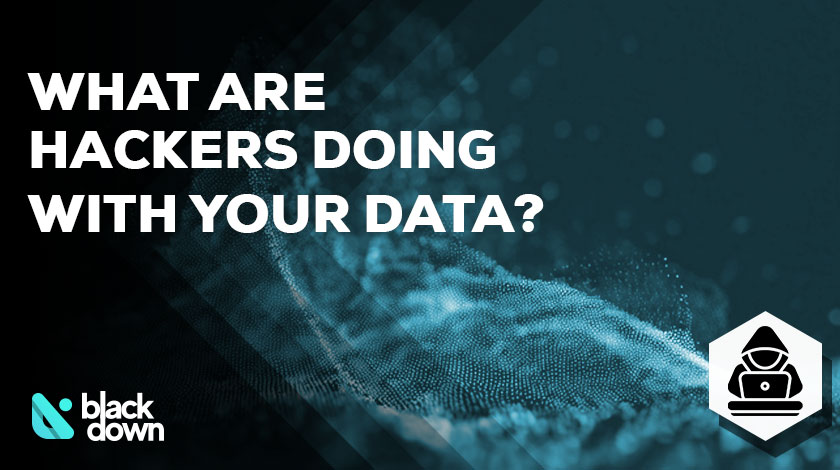Some hackers break into systems just for fun. But mostly, they do it for profit. They want any piece of personal information that could help them impersonate you and steal your assets.
But how does it work? How and when do they make money, and what can you do to break the cycle of data theft that drives cybercrime?
What Types of Data do Hackers Steal?
Whether they are after company secrets and proprietary research or have other objectives, hackers need personal information about the people involved to succeed. The information can help them get past company security measures.
However, in most hacking operations, personal data is the main target. They want Personal Identifiable Information (PII), like name, address, date of birth, and Social Security number. They also look for financial information, such as credit card numbers and bank login details. They use it to open credit accounts, drain bank accounts. Medical or tax information can be used to file false claims or tax returns.
They can also sell the data on dark web markets. Hackers can monetize the stolen data by selling it to other criminals.
Even Snippets of Data are Valuable
Did you know that your social media posts may provide just enough information for a hacker to trick you into revealing your password? There is a massive dark industry aimed at piecing together seemingly insignificant details to build comprehensive profiles of people. They can use data snippets like your favorite color or the street you grew up on to build an attack on you or your loved ones.
Cybercrime’s Endless Data Lifecycle
The dark web process of collecting, cleaning, enriching, and selling stolen or scraped data operates much like a legitimate business. There are distinct stages. Each stage adds value to the data, making it more usable and profitable for the next link in the chain.
Hackers initially gather raw data from breaches, scraping, and other methods. Scrapers collect public information from various online sources. Data brokers then buy, sell, and trade this data. Enrichers enhance the data by adding more personal details. The end users of this enriched data include fraudsters, ransomware gangs, and identity theft specialists.
Data Breachers or Hackers
Hackers collect raw data. They hack into systems, exploit vulnerabilities, or use social engineering to gather sensitive data. They use different tools and operate at different skill levels. Some use advanced malware, for example, ransomware or trojans. Others look for software exploits to get unauthorized access to systems. Some hackers focus on large corporations. Others specialize in healthcare systems or social media platforms.
Data Scrapers or Harvesters
These are people (assisted by automated bots) who gather public information from websites, social media, and forums. They collect tags, comments, and interests from people’s feeds. Then they correlate it with usernames, email addresses, interests, and personal histories.
Data Brokers
These are companies that buy, sell, and trade data. Some operate legally by tracking people’s activities via cookies and website fingerprinting technology. The darker side of the industry harbors companies that buy stolen or illegally gathered data from hackers on dark web marketplaces (such as the now-defunct Silk Road).
Data brokers, both legitimate and illicit, engage in data enrichment. They clean, organize, and add information from other sources to increase the value of each data set before selling it. Brokers sometimes buy bulk data sets from hackers or scrapers. Next, they standardize the formats. Then they add additional information gained from other sources, for example, social media.
Data Enrichers
This layer exists to add the devil to the details. Data enrichers specialise in combining information from different sources to make the collection more valuable. They blend raw data like email addresses or usernames and add information from cross-referencing social networks or public records. They may even buy other datasets to get specific types of personal information, such as job details or purchasing history.
For example, they can link an email address from a data breach to a LinkedIn profile. That gives them high-level information about a victim’s employer, job responsibilities, or financial status.
Fraudsters
Fraudsters use stolen data for financial gain. Using the enriched profiles, they commit identity theft, apply for credit, use stolen credit card details, or execute account takeovers. They also conduct social engineering schemes, like phishing.
Ransomware Operators and Data Extortionists
They are sophisticated, well-funded organizations. After locking down the victims’ files, they demand payment for the decryption key. If the victim doesn’t pay, they destroy or expose the data to embarrass the victim. Notorious groups like Conti and REvil are known for not only holding files hostage but also releasing sensitive information if the victim fails to pay.
Money Launderers or Resellers
There is yet another layer of dark web specialists that profit from your data. They don’t use the stolen data directly, but they launder the profits of cybercrime. They sell stolen credit card numbers, create fake accounts, or resell stolen identities. They use sophisticated tools, mixers, and cryptocurrency to hide the source and trail of the stolen money.
How to Protect Against the Exploitation of Common Weaknesses
Attackers exploit predictable behaviors, such as password reuse. Use these strategies to make it more difficult for others to piece together your information:
- Sign up for identity monitoring services that offer data removal. Using the Incogni data removal tool shrinks the amount of personal data floating around the internet. It reduces the chance of cybercriminals accessing your personal accounts or using this information for phishing attempts.
- Sign up for a credit monitoring service. Set alerts for new logins, credit inquiries, or unusual transactions.
- Adjust your social media privacy settings. Avoid sharing identifiable information, and don’t fill out optional profile fields. Lock down your social media profiles to prevent strangers and bots from scraping your personal details.
- Use a password manager to create strong passwords for your accounts.
- Use app-generated tokens or hardware keys for two-factor authentication instead of SMS text messages. That can prevent SIM swap attacks.
- Always verify contact requests from your service providers through a different channel. For example, if you receive a call from your bank, hang up and call them back directly before sharing any information or codes. Do not click on suspicious links or download untrusted attachments.
Reduce Your Exposure With Constant Vigilance
Once your personal information is out there, it’s hard to contain it. Dark web data enrichment will keep adding to the accuracy and size of the data. It will become a devastating tool in the hands of an attacker. We have to fight cybercrime with a combination of technology, education, and a commitment to safer online practices.
Thomas Hyde
Related posts
Popular Articles
Best Linux Distros for Developers and Programmers as of 2025
Linux might not be the preferred operating system of most regular users, but it’s definitely the go-to choice for the majority of developers and programmers. While other operating systems can also get the job done pretty well, Linux is a more specialized OS that was…
How to Install Pip on Ubuntu Linux
If you are a fan of using Python programming language, you can make your life easier by using Python Pip. It is a package management utility that allows you to install and manage Python software packages easily. Ubuntu doesn’t come with pre-installed Pip, but here…











